Sheldon Brown's
Bicycle Glossary St - Sz

|
![]()
The primary bicycle application for stainless steel is for spokes. Virtually all modern high-quality spoked wheels have stainless-steel spokes.
Stainless steel is also used for high quality control cables.
Conventional wisdom is that the standover height should permit 1-3 inches (2-8 cm) of clearance between the top tube and the crotch of a rider straddling the frame, for road use. For off-road riding, considerably more clearance is required. See my article on Frame Sizing.
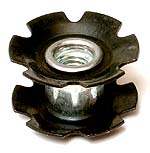
The star-fangled nut has two barbed steel flanges that allow it to be forced downward into the steerer, but which prevent it from moving upward.
If you ever need to remove a star nut, the easiest way is by driving it down and out the bottom of the steerer with a hammer and punch.
Star nuts are only for use on metal steerers and should never be used on carbon steerers. Forks with carbon steerers generally come with special expansion plugs that serve the function of a star nut, without the sharp edges that might damage the fragile carbon steerer.
Star nuts are available in several diameters to fit different types of forks.
Although steel is used for most high-quality bicycle frames, the use of steel instead of aluminum for many parts is often the result of penny pinching. Nobody should have to ride a modern bicycle with steel rims, brakes or handlebars. The only reason steel is now used for these parts is to scrimp on costs.
This was not always the case. As recently as the 1960's, steel was favored for many of these parts, particularly by the British. Indeed, for many years, Raleigh's slogan was "The All-Steel Bicycle". Steel parts of this era were often high in quality.
![]()
![]()
| Stem->Steerer fitting dimensions | |
|---|---|
| Nominal size | Stem diameter |
| Steerer Outside diameter (Thread less stem size) |
Steerer Inside diameter (Wedge-bolt stem size) |
| 1" Standard (25.4 mm) | 7/8"(22.2 mm) |
| 1 1/8" (28.6 mm) | 1" (25.4 mm) |
| 1 1/4" (31.8 mm) | 1 1/8" (28.6 mm) |
| BMX/ O.P.C. bikes | .833"(21.15 mm) |
| French 25 mm (obsolete) | 22mm |
| Stem->Handlebar fitting dimensions | ||
|---|---|---|
| Size | Application | |
| 22.2 mm | 7/8" | Steel bars. Mainly BMX, older Mountain bike bars. |
| 23.8 mm | 15/16" | Obsolete British size for steel handlebars, common on older 3-speeds. This size was also used for steel drop bars. |
| 25 mm | Obsolete French size. | |
| 25.4 mm | 1" | Standard I.S.O. size, used on the vast majority of newer bicycles. This is sometimes incorrectly called "mountain bike" size. |
| 25.8 mm | Unofficial in-between size used by some Italian handlebar makers for handlebars designed to be usable in either ISO (25.4) or Italian (26.0) size stems. | |
| 26.0 mm | Italian standard for drop bars, other bars made to fit Italian stems and some high-end aftermarket drop bars. This is sometimes incorrectly called "road" size. |
|
| 26.4 mm | Older Cinelli and Cinelli copies. Cinelli changed over to 26.0 in 1998. | |
| 27 mm | Titan (obsolete). | |
| 31.8 mm | 1 1/4" | Road oversized. |
"Road" vs "MTB." A common, misunderstanding makes a false distinction between "road" and "mountain" size stem/handlebar fitting. The vast majority of bicycles use the standard ISO 25.4 mm/1" size, whatever style of handlebar is used. High-end road bikes assembled with custom parts groups often use expensive aftermarket bars and stems, which do predominantly come in the Italian size, since the major makers of expensive bars/stems for road bikes are Italian. Non-Italian parts makers attempting to compete for the high end market often offer both sizes.
The range of handlebar positions available from a given stem depends on its height, angle and reach (extension.) Unfortunately, measurement procedures for determining these dimensions are not well-standardized in the industry, making it difficult to compare one stem with another based on the dimensions.
The custom of measuring reach along the line of the extension means that two stems of the same nominal reach will provide a different distance between the steering axis and the handlebar center, if they have different angles.
"Pop Top " Stems
Many newer stems use the "pop-top" attachment system for the handlebars, permitting the stem to be swapped without disturbing the handlebar grips/tape or brake/shift controls.
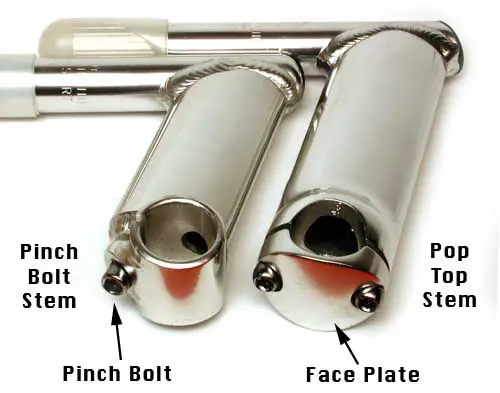
See also Hands Up! Adjusting Handlebar Height
Note: Steerers are butted at the bottom, so the hole in the steerer is constant-diameter until near the bottom, then the walls taper inward in the butted section.It is vitally important that the stem extender (or stem) not be inserted so far that the wedge is installed where the steerer is narrowing, or it could come loose unpredictably.
When this happens, only the edge/corner of the quill or wedge contacts the steerer, and it is trying to "grab" a slanted surface.
This is sometimes a problem on smaller frames if you try to insert the stem or a stem riser too far down into the steerer.
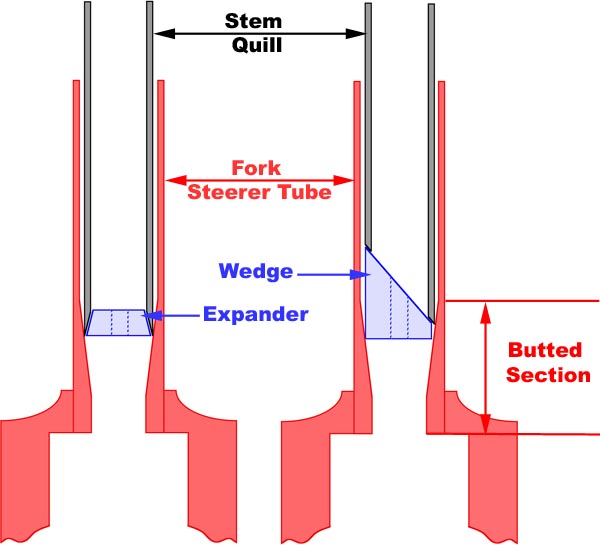
Illustration by Nicholas Flower
The term "stem" is sometimes also used to refer to a valve.
![]()
![]()
Unfortunately, this riding position gives rather poor control of the bicycle, mainly because the hands are too close together for good steering control. Also, stem shifters are difficult to shift precisely, because with the shifters behind the stem, there is nothing against which to rest the hand. Most stem shifters are friction shifters, worsening the problem.
Stem shifters also present a danger in a collision. Depending on what gear you have selected, stem shifters can be like having a dull knife aimed at your groin!
If your bike has stem shifters, consider upgrading to something safer and more convenient.
A Shimano buzzword standing for "System Total Integration". This normally is used to refer to Shimano's combined brake lever/shift lever systems, particularly those designed for drop handlebars. S.T.I. is similar to Campagnolo's Ergo system. S.T.I. uses the main brake lever, pushed inward, to select larger sprockets, and a smaller, auxiliary lever inside the brake lever to select smaller sprockets. [S.T.I has the advantage that it is not necessary to remove a hand from a brake lever to shift, but the disadvantage that the lever returns to the same position after every shift, so you can't tell by feel which sprockets you have selected until you get to the last one. And then you may have shifted to a crossover gear with a bad chain angle. An alternative for drop bars is bar-end shifters, which keep the hands on the handlebars, though not on the brake levers, and which move to a different position with each shift. Bar-end shifters are much less expensive, and less complicated, too. -- This comment added by John Allen]
See also the article on this site about repair of STI levers.
On fixed-gear bicycles that only have a single brake, some riders install a stoker lever on the other side of the handlebar for symmetry.
The modern bent design supplanted"straight pull" spokes in the 1890's. Since no bicycle technology ever disappears entirely, straight spokes get re-invented from time to time, but have not met with much commercial success in the last hundred years. They are seen on some "boutique" wheels.
A similar effect occurs with other materials, including those used to build bicycle frames. Good design avoids placing stress risers in heavily loaded areas of the frame.
![]()
![]()
This site also features a commemorative brochure celebrating the first fifty years of Sturmey-Archer 1902-1952, and a page on the ASC three-speed fixed gear hub.
Jane Thomas originated and I have re-posted excerpts from the 1956 Sturmey-Archer service manual.
Any standard-thread freewheel type hub will also accept a fixed-gear ("track ") sprocket . This is a common technique for converting an older bike to fixed gear on the cheap.
Despite the silly name, this is no more dangerous than using a freewheel, as long as you keep front and rear handbrakes installed.
Other major Sun Tour innovations included:
The Sun Tour name has been purchased and revived by Sakae Ringyo, though the new SR/Suntour parts are not compatible with the original Japanese SunTour parts.
For more, see the page about SunTour history.
See also Machined Rim Sidewalls
The later (1990s) "Superset II" design required special lugs, because it used an oversized down tube, ovalized at the bottom, also oversized oval chainstays. Bianchi was unique in using oversized and ovalized tubing with lugged construction, because the tooling for the special lugs was quite expensive.
In addition to adding to the comfort of the rider, suspension systems improve traction on bumpy surfaces, by keeping the tires in more nearly constant contact with the surface. (See sprung/unsprung weight) They also help protect the wheels from damage, by allowing them to spring out of the way when they hit something forcefully.
Suspension-corrected rigid forks mimic this geometry: they have longer blades to hold the head tube up to the same height a suspension fork would. If you desire to replace a suspension fork with a rigid fork, you should opt for a "suspension-corrected' rigid fork to preserve the frame's normal geometry.
It was published by Sutherland Publications, now Sutherland's Bicycle Shop Aids.
![]()
![]()
Better-quality cranks are made with the right crank and spider a single forging or casting, with no joint to fail. Forged cranks are not only more durable, but the chainrings tend to run straighter, providing better shifting performance.
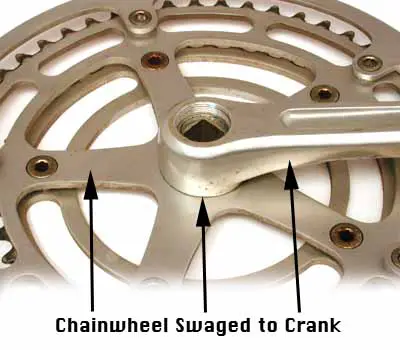
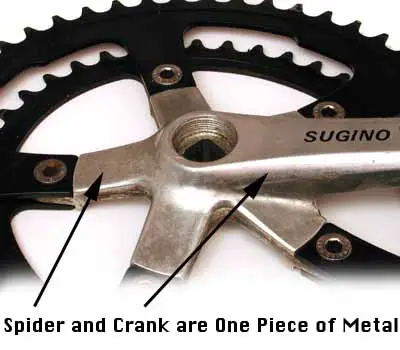
Swaged cranks were formerly common, but are now seen mainly on low-end bicycles. A swaged crank is an iffy proposition on a tandem, a fixed-gear bicycle, or a bicycle with a coaster brake, because applying force in both directions runs a substantial risk of loosening the chainwheel so it freewheels in both directions.
 |
|---|
| A Linear SWB recumbent |
See my Bottom Bracket "Crib Sheet."
These shifters are a bit problematical. Like other "friction " shifters, the lever friction is regulated by the bolt the lever pivots around. If you tighten that bolt a bit, the derailer will more or less stay in position. If you tighten it too much, it will be hard to move the lever. .
Unfortunately, these levers are a fundamentally flawed design. SunTour built in a special cam mechanism to make the front derailer move slightly to "trim " its position as you shifted the rear. This was a good idea -- it is a wonder that nobody else has taken it up -- but poorly executed.
The automatic "trimming" mechanism generally only works in one direction. Which direction that will be depends on the relative friction settings of the front and rear levers. Theoretically there's a particular balance point where it works right, but in practice this never works.
Sync chains generally connect equal-sized chainwheels, so the mechanical advantage is 1:1. This is true for all sizes of sync chainwheels, as long as they are both the same size. Smaller sync chainwheels, however, put a greater stress on the sync chain, the frame, and the bottom bracket bearings, so it is a mistake to make them too small in an attempt to save weight. Typical sizes are in the range of 38 teeth and up.
See also my article on Tandem Sync Chains.
It was Campagnolo's wish to make a system that would be compatible with its older derailers and other products, to provide an easy upgrade path for existing customers. This was a laudable goal, but turned out to be impractical.
The Synchro (and Synchro 2) down tube shift levers had replaceable, color-coded "indexing discs" with detent notches at different spacings. There were quite a few different indexing discs available for different freewheel models and spacings.
The problem that sank Synchro was cable travel. Campagnolo derailers had always used a very short cable travel from gear to gear. The shorter travel came with higher tension, and these two factors exacerbated issues of cable friction and stretch. As Shimano also discovered, a key to good indexing is long-travel, low-tension cable setups. Shimano also made a misstep with this: its original 1984 Dura-Ace S.I.S. system used a fairly short cable travel, requiring unusually-high precision in associated parts. When Shimano "trickled down" S.I.S. to the 600EX group in 1986, it went with a longer cable travel, which became the standard for the rest of the Shimano line. This led to a decade of incompatibility between Dura-Ace and the rest of the Shimano line, only resolved in 1997 when Dura-Ace went to 9-speed and lengthened the cable travel to match the rest of the line.
Currently, Campagnolo's shifters and derailers use an even longer cable travel than Shimano does.
Synchro derailers and shift levers are incompatible with anything else, and the Synchro system worked so poorly that it is not a good idea to try to set the system up on a bike you intend to actually ride.
![]()
![]()
![]()
Last Updated: by Harriet Fell